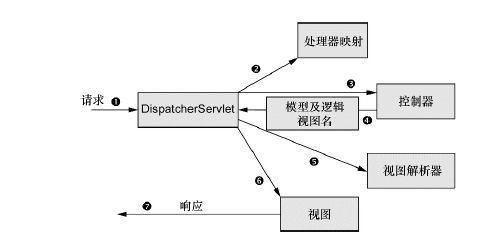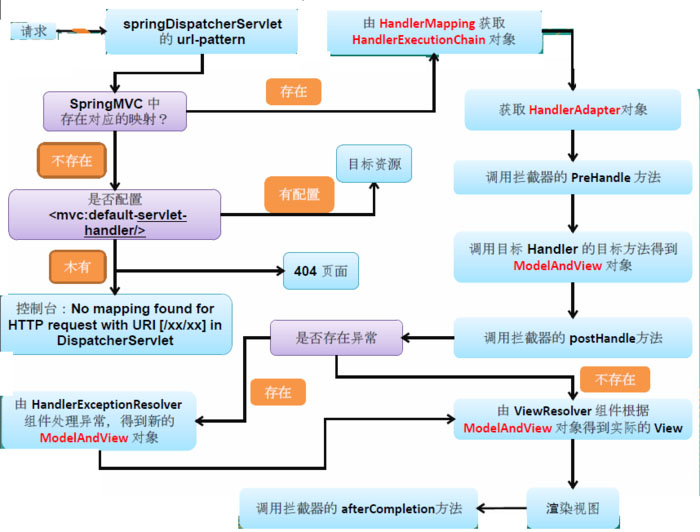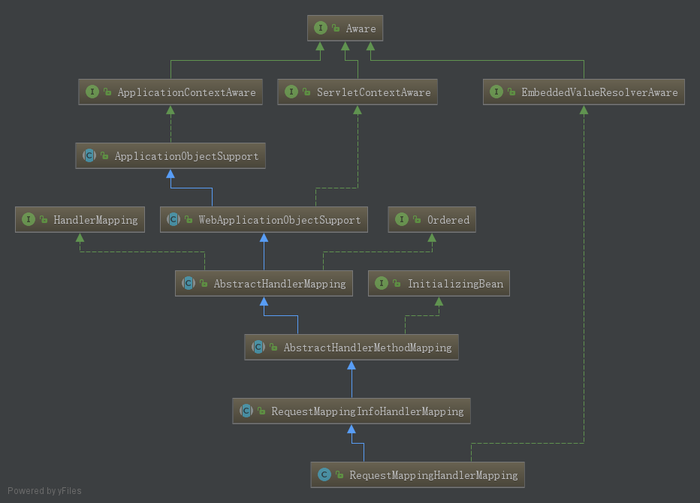您好,登录后才能下订单哦!
这篇文章将为大家详细讲解有关Spring MVC之Controller查找的示例分析,小编觉得挺实用的,因此分享给大家做个参考,希望大家阅读完这篇文章后可以有所收获。
1 SpringMVC请求流程

Controller查找在上图中对应的步骤1至2的过程

SpringMVC详细运行流程图
2 SpringMVC初始化过程
2.1 先认识两个类
1.RequestMappingInfo
封装RequestMapping注解
包含HTTP请求头的相关信息
一个实例对应一个RequestMapping注解
2.HandlerMethod
封装Controller的处理请求方法
包含该方法所属的bean对象、该方法对应的method对象、该方法的参数等

RequestMappingHandlerMapping的继承关系
在SpringMVC初始化的时候
首先执行RequestMappingHandlerMapping的afterPropertiesSet
然后进入AbstractHandlerMethodMapping的afterPropertiesSet
这个方法会进入该类的initHandlerMethods
负责从applicationContext中扫描beans,然后从bean中查找并注册处理器方法
//Scan beans in the ApplicationContext, detect and register handler methods.
protected void initHandlerMethods() {
...
//获取applicationContext中所有的bean name
String[] beanNames = (this.detectHandlerMethodsInAncestorContexts ?
BeanFactoryUtils.beanNamesForTypeIncludingAncestors(getApplicationContext(), Object.class) :
getApplicationContext().getBeanNamesForType(Object.class));
//遍历beanName数组
for (String beanName : beanNames) {
//isHandler会根据bean来判断bean定义中是否带有Controller注解或RequestMapping注解
if (isHandler(getApplicationContext().getType(beanName))){
detectHandlerMethods(beanName);
}
}
handlerMethodsInitialized(getHandlerMethods());
}
RequestMappingHandlerMapping#isHandler
上图方法即判断当前bean定义是否带有Controlller注解或RequestMapping注解
如果只有RequestMapping生效吗?不会的!
因为这种情况下Spring初始化的时候不会把该类注册为Spring bean,遍历beanNames时不会遍历到这个类,所以这里把Controller换成Compoent也可以,不过一般不这么做
当确定bean为handler后,便会从该bean中查找出具体的handler方法(即Controller类下的具体定义的请求处理方法),查找代码如下
/**
* Look for handler methods in a handler
* @param handler the bean name of a handler or a handler instance
*/
protected void detectHandlerMethods(final Object handler) {
//获取当前Controller bean的class对象
Class<?> handlerType = (handler instanceof String) ?
getApplicationContext().getType((String) handler) : handler.getClass();
//避免重复调用 getMappingForMethod 来重建 RequestMappingInfo 实例
final Map<Method, T> mappings = new IdentityHashMap<Method, T>();
//同上,也是该Controller bean的class对象
final Class<?> userType = ClassUtils.getUserClass(handlerType);
//获取当前bean的所有handler method
//根据 method 定义是否带有 RequestMapping
//若有则创建RequestMappingInfo实例
Set<Method> methods = HandlerMethodSelector.selectMethods(userType, new MethodFilter() {
@Override
public boolean matches(Method method) {
T mapping = getMappingForMethod(method, userType);
if (mapping != null) {
mappings.put(method, mapping);
return true;
}
else {
return false;
}
}
});
//遍历并注册当前bean的所有handler method
for (Method method : methods) {
//注册handler method,进入以下方法
registerHandlerMethod(handler, method, mappings.get(method));
}以上代码有两个地方有调用了getMappingForMethod
使用方法和类型级别RequestMapping注解来创建RequestMappingInfo
@Override
protected RequestMappingInfo getMappingForMethod(Method method, Class<?> handlerType) {
RequestMappingInfo info = null;
//获取method的@RequestMapping
RequestMapping methodAnnotation = AnnotationUtils.findAnnotation(method, RequestMapping.class);
if (methodAnnotation != null) {
RequestCondition<?> methodCondition = getCustomMethodCondition(method);
info = createRequestMappingInfo(methodAnnotation, methodCondition);
//获取method所属bean的@RequtestMapping注解
RequestMapping typeAnnotation = AnnotationUtils.findAnnotation(handlerType, RequestMapping.class);
if (typeAnnotation != null) {
RequestCondition<?> typeCondition = getCustomTypeCondition(handlerType);
//合并两个@RequestMapping注解
info = createRequestMappingInfo(typeAnnotation, typeCondition).combine(info);
}
}
return info;
}这个方法的作用就是根据handler method方法创建RequestMappingInfo对象。首先判断该mehtod是否含有RequestMpping注解。如果有则直接根据该注解的内容创建RequestMappingInfo对象。创建以后判断当前method所属的bean是否也含有RequestMapping注解。如果含有该注解则会根据该类上的注解创建一个RequestMappingInfo对象。然后在合并method上的RequestMappingInfo对象,最后返回合并后的对象。现在回过去看detectHandlerMethods方法,有两处调用了getMappingForMethod方法,个人觉得这里是可以优化的,在第一处判断method时否为handler时,创建的RequestMappingInfo对象可以保存起来,直接拿来后面使用,就少了一次创建RequestMappingInfo对象的过程。然后紧接着进入registerHandlerMehtod方法,如下
protected void registerHandlerMethod(Object handler, Method method, T mapping) {
//创建HandlerMethod
HandlerMethod newHandlerMethod = createHandlerMethod(handler, method);
HandlerMethod oldHandlerMethod = handlerMethods.get(mapping);
//检查配置是否存在歧义性
if (oldHandlerMethod != null && !oldHandlerMethod.equals(newHandlerMethod)) {
throw new IllegalStateException("Ambiguous mapping found. Cannot map '" + newHandlerMethod.getBean()
+ "' bean method \n" + newHandlerMethod + "\nto " + mapping + ": There is already '"
+ oldHandlerMethod.getBean() + "' bean method\n" + oldHandlerMethod + " mapped.");
}
this.handlerMethods.put(mapping, newHandlerMethod);
if (logger.isInfoEnabled()) {
logger.info("Mapped \"" + mapping + "\" onto " + newHandlerMethod);
}
//获取@RequestMapping注解的value,然后添加value->RequestMappingInfo映射记录至urlMap中
Set<String> patterns = getMappingPathPatterns(mapping);
for (String pattern : patterns) {
if (!getPathMatcher().isPattern(pattern)) {
this.urlMap.add(pattern, mapping);
}
}
}这里T的类型是RequestMappingInfo。这个对象就是封装的具体Controller下的方法的RequestMapping注解的相关信息。一个RequestMapping注解对应一个RequestMappingInfo对象。HandlerMethod和RequestMappingInfo类似,是对Controlelr下具体处理方法的封装。先看方法的第一行,根据handler和mehthod创建HandlerMethod对象。第二行通过handlerMethods map来获取当前mapping对应的HandlerMethod。然后判断是否存在相同的RequestMapping配置。如下这种配置就会导致此处抛Invocation of init method failed; nested exception is java.lang.IllegalStateException: Ambiguous mapping found. Cannot map...
异常
@Controller
@RequestMapping("/AmbiguousTest")
public class AmbiguousTestController {
@RequestMapping(value = "/test1")
@ResponseBody
public String test1(){
return "method test1";
}
@RequestMapping(value = "/test1")
@ResponseBody
public String test2(){
return "method test2";
}
}在SpingMVC启动(初始化)阶段检查RequestMapping配置是否有歧义,这是其中一处检查歧义的(后面还会提到一个在运行时检查歧义性的地方)。然后确认配置正常以后会把该RequestMappingInfo和HandlerMethod对象添加至handlerMethods(LinkedHashMap)中,静接着把RequestMapping注解的value和ReuqestMappingInfo对象添加至urlMap中。
registerHandlerMethod方法简单总结
该方法的主要有3个职责
1. 检查RequestMapping注解配置是否有歧义。
2. 构建RequestMappingInfo到HandlerMethod的映射map。该map便是AbstractHandlerMethodMapping的成员变量handlerMethods。LinkedHashMap。
3. 构建AbstractHandlerMethodMapping的成员变量urlMap,MultiValueMap。这个数据结构可以把它理解成Map>。其中String类型的key存放的是处理方法上RequestMapping注解的value。就是具体的uri
先有如下Controller
@Controller
@RequestMapping("/UrlMap")
public class UrlMapController {
@RequestMapping(value = "/test1", method = RequestMethod.GET)
@ResponseBody
public String test1(){
return "method test1";
}
@RequestMapping(value = "/test1")
@ResponseBody
public String test2(){
return "method test2";
}
@RequestMapping(value = "/test3")
@ResponseBody
public String test3(){
return "method test3";
}
}初始化完成后,对应AbstractHandlerMethodMapping的urlMap的结构如下

以上便是SpringMVC初始化的主要过程
查找过程
为了理解查找流程,带着一个问题来看,现有如下Controller
@Controller
@RequestMapping("/LookupTest")
public class LookupTestController {
@RequestMapping(value = "/test1", method = RequestMethod.GET)
@ResponseBody
public String test1(){
return "method test1";
}
@RequestMapping(value = "/test1", headers = "Referer=https://www.baidu.com")
@ResponseBody
public String test2(){
return "method test2";
}
@RequestMapping(value = "/test1", params = "id=1")
@ResponseBody
public String test3(){
return "method test3";
}
@RequestMapping(value = "/*")
@ResponseBody
public String test4(){
return "method test4";
}
}有如下请求

这个请求会进入哪一个方法?
web容器(Tomcat、jetty)接收请求后,交给DispatcherServlet处理。FrameworkServlet调用对应请求方法(eg:get调用doGet),然后调用processRequest方法。进入processRequest方法后,一系列处理后,在line:936进入doService方法。然后在Line856进入doDispatch方法。在line:896获取当前请求的处理器handler。然后进入AbstractHandlerMethodMapping的lookupHandlerMethod方法。代码如下
protected HandlerMethod lookupHandlerMethod(String lookupPath, HttpServletRequest request) throws Exception {
List<Match> matches = new ArrayList<Match>();
//根据uri获取直接匹配的RequestMappingInfos
List<T> directPathMatches = this.urlMap.get(lookupPath);
if (directPathMatches != null) {
addMatchingMappings(directPathMatches, matches, request);
}
//不存在直接匹配的RequetMappingInfo,遍历所有RequestMappingInfo
if (matches.isEmpty()) {
// No choice but to go through all mappings
addMatchingMappings(this.handlerMethods.keySet(), matches, request);
}
//获取最佳匹配的RequestMappingInfo对应的HandlerMethod
if (!matches.isEmpty()) {
Comparator<Match> comparator = new MatchComparator(getMappingComparator(request));
Collections.sort(matches, comparator);
if (logger.isTraceEnabled()) {
logger.trace("Found " + matches.size() + " matching mapping(s) for [" + lookupPath + "] : " + matches);
}
//再一次检查配置的歧义性
Match bestMatch = matches.get(0);
if (matches.size() > 1) {
Match secondBestMatch = matches.get(1);
if (comparator.compare(bestMatch, secondBestMatch) == 0) {
Method m1 = bestMatch.handlerMethod.getMethod();
Method m2 = secondBestMatch.handlerMethod.getMethod();
throw new IllegalStateException(
"Ambiguous handler methods mapped for HTTP path '" + request.getRequestURL() + "': {" +
m1 + ", " + m2 + "}");
}
}
handleMatch(bestMatch.mapping, lookupPath, request);
return bestMatch.handlerMethod;
}
else {
return handleNoMatch(handlerMethods.keySet(), lookupPath, request);
}
}进入lookupHandlerMethod方法,其中lookupPath="/LookupTest/test1",根据lookupPath,也就是请求的uri。直接查找urlMap,获取直接匹配的RequestMappingInfo list。这里会匹配到3个RequestMappingInfo。如下

然后进入addMatchingMappings方法
private void addMatchingMappings(Collection<T> mappings, List<Match> matches, HttpServletRequest request) {
for (T mapping : mappings) {
T match = getMatchingMapping(mapping, request);
if (match != null) {
matches.add(new Match(match, handlerMethods.get(mapping)));
}
}
}这个方法的职责是遍历当前请求的uri和mappings中的RequestMappingInfo能否匹配上,如果能匹配上,创建一个相同的RequestMappingInfo对象。再获取RequestMappingInfo对应的handlerMethod。然后创建一个Match对象添加至matches list中。执行完addMatchingMappings方法,回到lookupHandlerMethod。这时候matches还有3个能匹配上的RequestMappingInfo对象。接下来的处理便是对matchers列表进行排序,然后获取列表的第一个元素作为最佳匹配。返回Match的HandlerMethod。这里进入RequestMappingInfo的compareTo方法,看一下具体的排序逻辑。代码如下
public int compareTo(RequestMappingInfo other, HttpServletRequest request) {
int result = patternsCondition.compareTo(other.getPatternsCondition(), request);
if (result != 0) {
return result;
}
result = paramsCondition.compareTo(other.getParamsCondition(), request);
if (result != 0) {
return result;
}
result = headersCondition.compareTo(other.getHeadersCondition(), request);
if (result != 0) {
return result;
}
result = consumesCondition.compareTo(other.getConsumesCondition(), request);
if (result != 0) {
return result;
}
result = producesCondition.compareTo(other.getProducesCondition(), request);
if (result != 0) {
return result;
}
result = methodsCondition.compareTo(other.getMethodsCondition(), request);
if (result != 0) {
return result;
}
result = customConditionHolder.compareTo(other.customConditionHolder, request);
if (result != 0) {
return result;
}
return 0;
}代码里可以看出,匹配的先后顺序是value>params>headers>consumes>produces>methods>custom,看到这里,前面的问题就能轻易得出答案了。在value相同的情况,params更能先匹配。所以那个请求会进入test3()方法。再回到lookupHandlerMethod,在找到HandlerMethod。SpringMVC还会这里再一次检查配置的歧义性,这里检查的原理是通过比较匹配度最高的两个RequestMappingInfo进行比较。此处可能会有疑问在初始化SpringMVC有检查配置的歧义性,这里为什么还会检查一次。假如现在Controller中有如下两个方法,以下配置是能通过初始化歧义性检查的。
@RequestMapping(value = "/test5", method = {RequestMethod.GET, RequestMethod.POST})
@ResponseBody
public String test5(){
return "method test5";
}
@RequestMapping(value = "/test5", method = {RequestMethod.GET, RequestMethod.DELETE})
@ResponseBody
public String test6(){
return "method test6";
}现在执行 http://localhost:8080/SpringMVC-Demo/LookupTest/test5 请求,便会在lookupHandlerMethod方法中抛java.lang.IllegalStateException: Ambiguous handler methods mapped for HTTP path 'http://localhost:8080/SpringMVC-Demo/LookupTest/test5'异常。这里抛该异常是因为RequestMethodsRequestCondition的compareTo方法是比较的method数。代码如下
public int compareTo(RequestMethodsRequestCondition other, HttpServletRequest request) {
return other.methods.size() - this.methods.size();
}什么时候匹配通配符?当通过urlMap获取不到直接匹配value的RequestMappingInfo时才会走通配符匹配进入addMatchingMappings方法。
关于“Spring MVC之Controller查找的示例分析”这篇文章就分享到这里了,希望以上内容可以对大家有一定的帮助,使各位可以学到更多知识,如果觉得文章不错,请把它分享出去让更多的人看到。
免责声明:本站发布的内容(图片、视频和文字)以原创、转载和分享为主,文章观点不代表本网站立场,如果涉及侵权请联系站长邮箱:is@yisu.com进行举报,并提供相关证据,一经查实,将立刻删除涉嫌侵权内容。